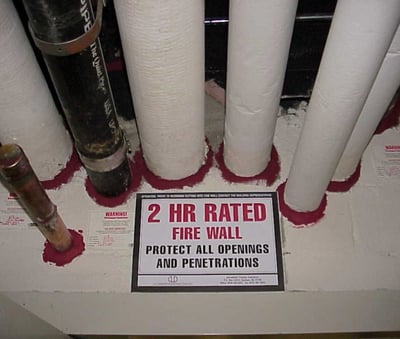Firestop Marking and Identification
We all rely on signs to help us navigate in unfamiliar surroundings. Anyone disembarking from an airplane outside of their home base needs the guidance of signage to find the baggage claim and ground transportation. Imagine trying to take a hike in the woods without a properly blazed trail. The well-known song might opine that signs are everywhere and are blocking out the scenery, but signs are undeniably useful given the right set of circumstances. This is especially true when one considers firestopping.
Once a firestop has been installed in the field, the details and reasoning behind that particular application are likely to vanish as soon as the contractor leaves the jobsite unless some form of permanent identification is left as a record. While recent efforts to codify the requirement of labeling firestops were shown strong support in the Committee Action Hearings of the International Code Council (ICC), the efforts fell just short of the required votes necessary to push this proposed code change through and presently there are no specific requirements within the building codes that prescribe a methodology for installing labels at firestops. However, the use of firestop identification is widely recognized as a best practice within the industry. The FCIA Firestop Manual of Practice (MOP) provides useful background information on firestop identification and offers examples of the different types of field labels that can be applied at a firestop. 
The International Building Code (IBC) does include language that under certain conditions requires fire walls, fire barriers, fire partitions, smoke barriers and smoke partitions to include a means of identification and a warning to protect all openings. These specific requirements are outlined in Section 703.7 within the 2012, 2015 and 2018 Editions of the IBC. Although labels are not mandated at firestops by the building codes, they are likely to prove beneficial both economically and logistically when considered over the life of a building when provided. Inspections and maintenance performed after the firestop installation are greatly simplified when the original system is already known and there is no need to research the intended purpose of the past work. It is a somewhat controversial topic to assert that the building codes should require firestops to be labelled since there is a material cost for the signs and a labor cost for their installation. However, there are also many indisputable benefits to the building owner and occupants when firestop labels are used. Firestops are a matter of life safety and should be as easy to recognize and maintain as possible.
It is highly recognized that any effort put into labeling firestops would benefit from standardizing the approach to insure labeling would be consistent in both information and appearance. Because of this, and the value proper and consistent labeling would provide, a work item has been initiated through the ASTM E06 Committee to create a standard to develop this practice in the hopes that, ultimately, labeling would be recognized as more than just a best practice, but also a valuable asset to the inspection community and to life safety in general. While the practice will create cost, we believe that the value created will offset the cost in a significant way.






